Milk kefir is made from kefir grains – a symbiotic colony of bacteria and yeast (SCOBY). It is traditionally used as a probiotic drink, however, it’s also great for smoothies or as a buttermilk substitute. It can even thicken like yogurt!
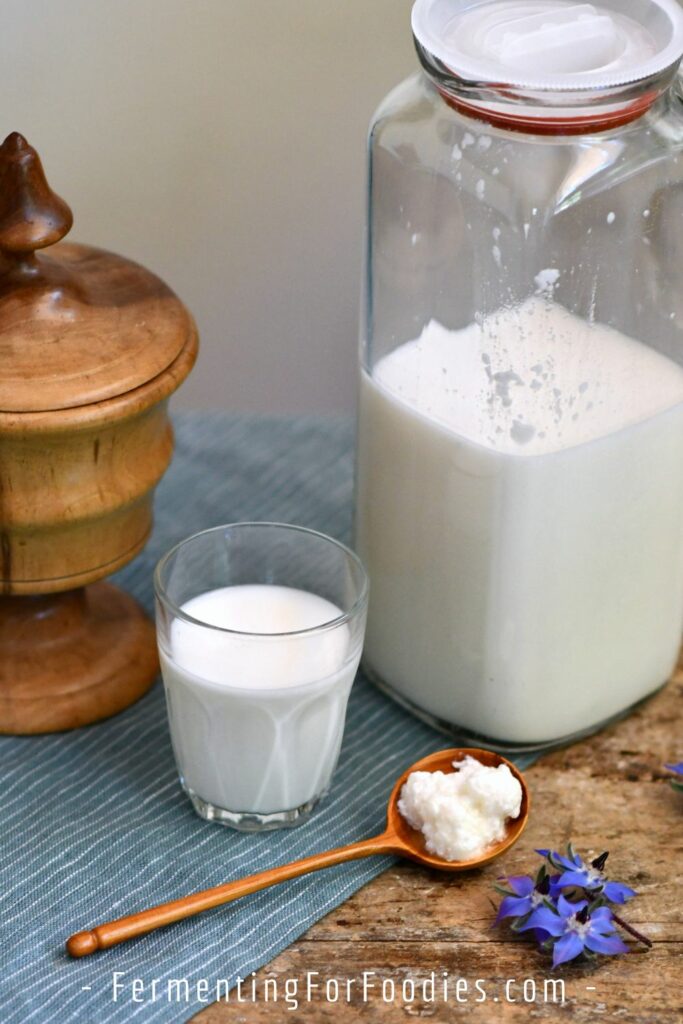
I’m really lucky. My homemade kefir grains are descended from the culture that has been in my husband’s family for years. They are part of a tight-knit community from the Caucasus. The birthplace of milk kefir. So it’s quite likely that my kefir grains were brought over to Canada by some relation.
No pressure kids… but you got to take care of the family kefir grains. They belonged to your great, great grandparents!
Why make milk kefir?
Homemade milk kefir is not the same as store-bought kefir. Store-bought kefir is usually just a mix of bacterial cultures, resulting in a drinkable yogurt. Because traditional kefir is made from a symbiotic culture of yeast and bacteria, it is not shelf-stable enough for grocery stores.
However, milk kefir is the perfect dairy culture for home use.
- It is much easier to make than yogurt. Since it ferments at room temperature, you don’t need to heat the milk before culturing.
- Milk kefir is a great replacement for buttermilk in baking.
- You can use kefir grains to culture whipping cream for ice cream and cultured butter.
- You can use it to make soft cheese.
- Kefir can be used as a starter culture (either as whey or straight kefir) for fermenting most everything.
- Cultured dairy is the best way for probiotics to survive digestion.
- Milk kefir has many health benefits.
Where to get kefir grains
The most difficult part of making kefir is finding the kefir grains. Most health food stores carry a powdered “kefir” starter, which isn’t actually real kefir. It’s a bunch of the bacteria strains found in kefir and is not robust enough to be reculture more than just a few times.
If you want to maintain your own colony of kefir grains then you need to either buy freeze-dried grains or make friends with someone who has grains.
Types of kefir grains
There are a few different types of milk kefir grains.
I have a single, larger, cauliflower-like grain. While it does occasionally make babies, it usually stays in one large mass.
When I was a Tracebridge, Katie’s grains were very different from mine. They were individual little grains that needed to be strained from the milk. So clearly there are a few varieties out there!
I highly recommend getting a larger cauliflower-like grain. It is so much easier to maintain because it floats after it’s finished fermenting. So you just need to scoop it off the top of the milk. No need to strain the kefir.
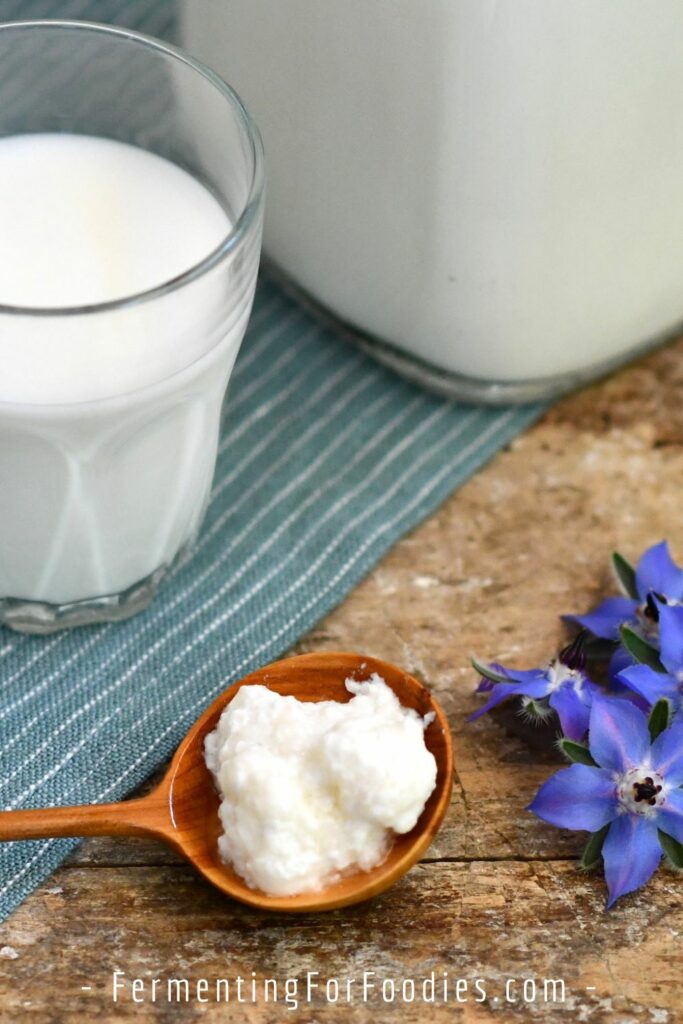
Everything you need to know about milk kefir
The recipe below provides information on how to make a single batch of kefir. Here are some more details for anyone wanting to know everything there is to know about milk kefir.
1. How to take care of kefir grains
- Kefir is happiest in fresh milk at room temperature. Try to pace your culturing so that you can keep your kefir out of the fridge for at least 3 days a week. If you only use a little bit of kefir, then just culture 2 cups at a time with 1 Tbsp of grains.
- Happy kefir will keep multiplying, so you’ll end up with more grains than you’ll need. Though the grains are edible, I would recommend passing them along to a friend instead.
- If your grains turn a funny color, then it’s likely that they’ve picked up some invasive mold/bacteria. Unfortunately, the best way to fix this is to throw them out and start anew. (I’ve had my grains go pink on me a few times. Luckily, I was able to get a new batch from Brad’s mom).
- Kefir can contaminate other cultures (yogurt, sourdough, etc.). It’s best to store your ferments in different rooms.
- You don’t need to wash your grains. They just need fresh milk to keep them healthy and strong. Water is unnecessary and probably harmful considering your water is likely chlorinated. I haven’t washed my grains in years… in fact, washing my grains was probably why they went pink!
- As long as you aren’t using a reactive metal (like copper or cast iron), it’s fine to use metal with your grains.
- If you need to take a break from culturing, then you can leave your kefir grains in double the recommended amount of milk, in the fridge for up to 4 weeks.
- Here’s some advice for traveling with your grains.
Flavoring kefir
Milk kefir can be used as a replacement for buttermilk, yogurt, or milk. It can taste strong and sour, or mild and creamy depending on how long you culture it. If you find the flavor too strong, reduce your culturing time. It’s fine to culture it for only 4 to 6 hours if you prefer the taste!
We serve plain kefir as milk for breakfast. And since cereal is our usual weekday breakfast, we go through plenty of kefir!
Here are the two main methods of flavoring kefir:
- Add the flavor right when you serve it, by mixing in fresh fruit, juice, or jam.
- Do a second round of fermentation by adding flavors to kefir after removing the grains. This results in a soda-like beverage. If you want more info, here’s a post on how to make milk kefir sodas.

Making thick kefir
Kefir will naturally thicken during culturing. But it is a careful dance between lovely thick kefir, and separated over-cultured kefir. (Here’s a post on what to do with over-cultured kefir).
There isn’t a perfect recipe to prevent kefir from over-culturing. It will depend on:
- the milk to grain ratio
- culturing temperature
- type of milk (even different brands of milk will impact kefir)
If you really want thick, yogurt-like kefir, then you will need to heat the milk to 180 F (80 C). This will denature the milk proteins allowing them to thicken when exposed to acid. Be sure to allow the milk to cool to room temperature before adding the kefir grains. Otherwise, you could accidentally kill your kefir grains.
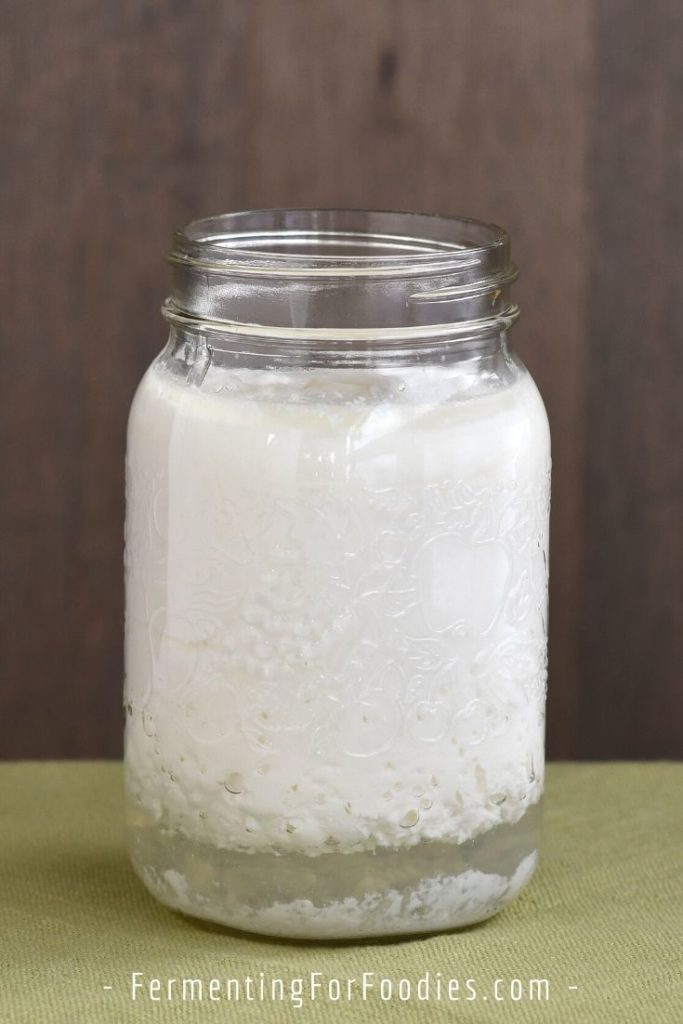
How To Make Milk Kefir
Want to make milk kefir? Here’s everything you need to know about how to make your own probiotic and delicious kefir. It is so much easier than yogurt!
- Prep Time: 5 minutes
- Total Time: 5 minutes
- Yield: 1 liter 1x
- Category: Beverage
- Method: Fermented
- Cuisine: Caucasus
- Diet: Vegetarian
Ingredients
- 4 cups (1 L) of milk (see notes)
- 2 Tbsp of kefir grains (see the section above for details)
Instructions
- This basic recipe is perfect for making thick milk kefir. See the sections above for details on making smaller batches or keeping your kefir from over-culturing.
- Mix the milk and kefir grains in a glass jar or pitcher. Cover with a loose-fitting lid, cloth, or paper towel. You don’t want to use an air-tight lid as kefir will carbonate. Leave the container out at room temperature for a minimum of 4 hours and up to 24 hours depending on how strong you want the kefir to be. The longer you leave it the more sparkling and sour it will become. We like to culture for 6 to 8 hours.
- To slow down the fermentation, store the kefir in the fridge. When you are ready to enjoy your homemade milk kefir, remove the grains and place them in fresh milk for reculturing.
- Store the finished kefir in the fridge. It will continue to ferment, so you will end up with separated kefir if you don’t drink it within a few days. See the section above for more details on how to take care of your kefir grains and flavor your milk kefir.
Notes
- It’s fine to use cow’s milk, goat’s milk, or sheep’s milk. However, you will need to use a different recipe to make vegan kefir using coconut milk.
- My kefir grain usually floats after 8 hours of fermenting, so I simply scoop it out with a spoon. If you have the tiny kefir grains then you will need to pour your kefir through a strainer.
- If you have too many grains or you leave your kefir out on the counter too long you will end up curdling your milk. This is perfectly good to eat! Turn it into kefir cheese for a delicious and probiotic cheese spread.

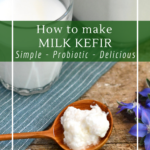

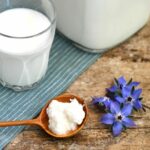
thanks for sharing this infomation
Glad you found it helpful.
We always a have a fresh jug of this in the fridge for morning cereal. We leave it out on the counter for the day or the night only to prevent it from getting too fermented; kids dig it as long as it’s not separated. We also noticed that sometimes it turns into a wonderful yoghurty version of itself, with these huge blocks of curd that are like sweet yoghurt. It’s not consistent though. Do you know how or why that happens?
There are lots of factors that can affect how fast kefir ferments. The grains to milk ratio, room temperature. Kefir has a bit of its own Goldilocks effect.
You can also get nice thick kefir from culturing it with the grains for a shorter time, then letting it finish fermenting without the grains.
There have been few times after 12-24 hours, the milk has not thickened and it is the same consistency of when I poured out in. Any ideas about that?
I have made kefir every day for the past 6 years… and I would have to say that kefir is moody. 🙂 I find it thickens best when in a container that it has already cultured in a few times. But it’s also a bit like Goldilocks… it likes it warm, but not too warm. Enough grains but not too many grains.
If you can’t find anywhere local, try amazon: https://www.fermentingforfoodies.com/archives/category/products/cultures
Thanks for the tips. The ‘don’t use metal utensils’ myth stopped me from staring my batch. Do you know how hard it is to find a nylon sieve?
Have just discovered Ribot milk (Lait ribot) here in France which I’m pretty sure is a version of kefir, any ideas?
Actually, lait ribot is more like buttermilk, and it’s very easy to culture: https://www.fermentingforfoodies.com/lait-ribot/
I got some milk kefir grains from another person in my town last week. It is pretty warm, even in my air conditioning in Texas summer. If I leave out the kefir for a day, (12 hrs) it separates. If I leave it out until the grains are floating, it isn’t thick at all. Any suggestions? I’d like it a little thicker. I’m using about a tbsp. Of grains, 2 c whole organic milk.
Try taking the grains out after 12 hours and letting it thicken out on the counter for another few hours. Or remove the grains and leave it to thicken in the fridge for 2 days. It really isn’t an exact process. My kids prefer it when kefir isn’t too thick, so they just use that, and I get to have the thicker kefir.
Hello!!
Looking for advice on maintaining a milk kefir sourdough starter – do I “feed” it with water or milk kefir after the initial bubbles start to form?
Thanks!
I just use milk kefir to start the sourdough, afterwards I feed it water and flour, just like a normal sourdough. If you have trouble maintaining a starter, then maybe just make new kefir sourdough each time? If you’re anything like me, then you probably always have a surplus of milk kefir!
Hi I have been trying to make milk kefir for about 2 weeks now with not much luck. It is nothing like the store kefir…its not sour at all and just has a strange taste and smell. I cant even describ it. I have tried different amounts of milk with different times and it’s all about the same. I love the sourness and flavor of the plain store bought kefir, but I’m getting nervous that homemade kefir is just not for me. What am I doing wrong?
Hi Jenn,
Where did you get your kefir grains from? Are they freeze dried or from a friend? It can take a while to reconstitute kefir grains. My kids like really mild kefir, so I only leave it out to culture for about 5 hours with 1 tbsp of grains for 3 cups of milk. Maybe try making really mild kefir to see if you like that better. It should taste like yogurt or store-bought kefir, but it won’t be thick. As it thickens the flavour will become more sour and slightly sparkly, which comes from the yeast in the kefir grains. Store-bought kefir is generally just bacterial strains, so it will have a slightly different flavour.
If you still don’t like mild kefir, then try using store-bought kefir to culture a buttermilk-like beverage. Check my recipe for buttermilk for instructions. Enjoy!
In an effort to help my sourdough starter, I placed my milk kefir next to it on the counter. I did not know that this was not a good idea. My sourdough definitely got a boost and was happy. However, in the last couple days, my kefir grains have a pinkish tinge. The kefir looks and smells normal, it’s just the grains with this pink color and it’s only on the interior parts of the grains. Are the grains bad? Thanks in advance for your input.
I’ve had my milk kefir grains go pink on me a few times. Though never from sourdough starter. Usually, it’s because I went away on holiday and didn’t feed them. It’s not always permanent. Try “cleaning” your grains by putting them in a small amount of fresh milk, culturing for a few hours, then putting them in a new batch of fresh milk. Do this 2-3x and hopefully, the grains will come out alright. Otherwise, maybe you can get some new grains? I’m always sharing my grains around, so the last time I had an issue I just got a new set of grains from a friend. Good luck!
Thank you!
When you say 1 tbls of kefir grains what would the weight be in grams to how many millilitres of milk. I am in England and don’t do cups. Thank you Lesley.
I’m in Canada, so I do both! However, most of my readers are in the USA which is why I write in imperial. 🙂 It’s about 15 mL of kefir grains for 1 Litre of milk. The exact measurement is not required. Just use a large spoonful.
Do I need to sterilize my jar before I put I the milk and grains?
Also do you have any tips for going from the grains I received from a friend who used 2% pasteurized milk cows milk to raw unpasteurized cows milk ?
No need to worry about sterilizing the jar with milk kefir. Clean should be good enough. They’re quite a strong culture. I haven’t personally switched to raw milk. But I have switched between cow and goat milk without any issues. My only thoughts are that the natural bacterial culture in raw milk may influence the kefir grains. However, I’m sure they’ll accommodate. They may even have strains in common. My bet is that the grains will just take on the bacterial strains found in the raw milk.
Enjoy!
Hi Emillie,
This is gold knowledge from experience. I’m getting interested in making my own kefir, and you provided thorough insight enough for me to feel confident enough to start the experimenting journey into this culture.
Thank you!
Warmly,
M
Thanks!
I’ve been doing alot of research but have many questions still (and there are many opinions out there on how to go about this journey!). I liked what you had to say. Received my kefir grains from Cultures for Health (CFH) on 12/10/20 and have successfully activated them (up to 4 C. milk per ferment). I have about 1 t. grains that are doing a nice job of culturing my milk (I broke the clumping ones apart with my clean fingers at one point). I use cold milk to feed them, as per guidance from CFH. I want to cut down the amount of kefir (to roughly 2.5 C./d) soon and don’t know if it’s too soon to dry some of the grains and store in the fridge surrounded by dry milk. My grains just barely got fully activated. I live in VT and we have our wood stove going. The last few ferments were done between 14 and 16 hrs. so I move the jar around to try to try to manipulate timing so I’m awake when I need to strain it. I’ve shared some with friends and today am draining the most recent batch to make cream cheese. Do you have any suggestions about decreasing the amount of kefir I’m making? Thanks!
Wow, that is quite the production! I’m assuming you got them in December, so they’re only 5 days old. I think you should probably keep feeding them rather than dehydrating them. One way to slow production is to ferment outside of the fridge for 8 hours then move to the fridge for up to 2 days. Then you can have fresh kefir every 2 days.
You could also make kefir grains your go-to gift this holiday season! It’s good to know a few people with grains because then if something unfortunate happens, you’ll be able to get them back again. And don’t worry about using a stainless steel knife to split your grains.
Lastly, I use kefir for a lot of my baking… and have a ton of kefir/buttermilk based recipes on my site. Usually, I write the recipes with buttermilk because it’s easier for readers to find… but I exclusively use milk kefir for baking. Enjoy!
Emillie…thank you SO MUCH for getting back to me so quickly. What an excellent idea that I have yet to read elsewhere. I really like the idea of partially fermenting then moving the milk to the fridge. I presume you’re suggesting that the grains will stay in the milk the whole time? If so, they’ll be cozy and warm, then chilly for a day or 2. When I gather them to start a new batch, will it take them longer to ferment the milk? Unfortunately I don’t think I know anyone who would want to take on this project : ) I’ll ask around…..Lynn
I’ve never noticed an issue with having the grains in the fridge for up to 2 days. However, your new grains may need more TLC. Another idea I thought of is that after using the same jar for a few days it builds up the culture on the bottom and that always causes it to thicken twice as fast. So maybe keep switching into clean jars if it’s still going too fast for you.
Your suggestions have been helpful ~ thank you. I had been too nurturing and a bit fearful about hurting my grains. Rather than put them in the fridge so soon after activating, I am now putting the culturing milk in a ‘cool’ space (I have a few rooms right now that are 50-56 F) after about 8 or so hours in a ‘warm’ spot. I try to keep them between 68 and 72 after feeding them, because they cultivate too quickly in warmer spaces. I’ve been able to manipulate my grains to produce kefir in roughly 24 hrs. from 12-14 hrs. at one point (for 2 batches), which was way too much kefir. So far, so good – my grains are active and don’t seem to mind the chill. At some point soon, I’ll try putting them in the fridge as you suggest. According to the company I bought them from, I’m supposed to keep culturing 4 C. of milk for 3-4 weeks before drying some of the grains. I am using the kefir in various ways but will check out your recipes, too. It’s also been fun to share the kefir. I appreciate this correspondence!
Glad I could help!
Hi! Thanks so much for all this info, especially the tip on not washing/rinsing the kefir grains. One of the fermenting books I got from the library recommended rinsing grains btwn each batch but other books didnt…..
What about the Mason jar I use to culture the milk? How often should this be rinsed/scrubbed out, in your experience? My guess is that every time is too much, but never would leave the jar full of crusted dairy residue, especially at the top. Thanks!
I would clean the jar just like you describe… only when the clumps of kefir start to build up on the inside. At our house we rotate between two jars and each jar gets cleaned about once a week. I’ve been making kefir with my grains for around 9 years and have never rinsed them. Enjoy!
Great, thanks – makes sense!
Just discovered your site and I love it!
Thanks!
Emillie ~ I’m needing your advice again! I’ve had active grains producing app. 2.5 C. of milk kefir since late Dec. ’20. They multiply quickly, it seems, and I’ve regularly dried some to store in the fridge in the last 2 mos. Last night (in frigid, howling windy VT), I put them in a cool space (our attic) so they wouldn’t over culture overnight. The door to the eave wasn’t properly latched and the winds (-25 F windchills) blew the door open and this morning my kefir was at 25F (it was no doubt exposed somewhat to moving air). I removed the grains and fed them 2 C. fresh milk and they’re in a warm spot right now. I can’t find any info anywhere as to whether or not they likely died in that culturing milk in those conditions. Luckily I have back-up grains, but this would be the first time activating grains I dried. I presume I got freeze dried grains from Cultures for Health. Any thoughts you may have are welcome….
Phew, that is cold! Well, kefir should be able to handle freezing (maybe not -25F, but 25F should be fine). So moving to fresh milk will likely work and everything will get back to culturing nicely in the next day or so. If not, using your home dried grains should also work, especially as they are not very old. Good luck!
This looks so good! What a great way to enjoy a natural probiotic!
Thanks for sharing! Do they keep long?
I’m assuming you mean the grains? I’ve had mine since 2012… so quite a long time!
Hi there! Real quick question about checking out my jars for kefir. Usually I ferment in a jar, pour the whole thing through a colander into a bowl, then place the kefir grains back in the same jar. I used to clean and dry the jar with soap and water, but now I just leave the residues and add fresh milk. Do I need to worry about milk souring or old kefir on the bottom going bad? Should I just wash once a week?
We do a version of the same thing. Though we switch jars so the kefir is out on the counter and the old jar of finished kefir in the fridge. We rotate this way between 2 jars and mostly finish a jar of kefir a day. We do end up washing the jars about once every two weeks… when the kefir residue really starts to build up on the sides of the jar. It’s not an issue… it’s just that my kids are fussy about it as it tends to make the kefir taste sourer. Enjoy!
Dear Emillie,
I have been making milk kefir for many months with complete success. I ususally put the new batch on the counter in the morning and I’ve left it for 24 hours with no problems. Yesterday, I forgot about it and it was afternoon when I remembered! It was completely separated and when I tried to strain it, I had yellow whey and the curds were very solid. I tried shaking it back together with no success. So I fished the grains out with clean fingers and they were huge ………..bigger than before the “over fermenting” situation. So, I’m not sure if they’ll work as a new batch. However, I have some milk kefir grains frozen that I will thaw and try to ferment into kefir. Do you ever freeze your grains? This was my first failure and hope it’s the last. Think I’ll make kefir cheese out of these curds……what say you? I love your website!
Hi Pat,
The grains sound fine. If they’ve grown, it’s probably because they’re really healthy. I usually divide my grains every few months and give them to a friend! I also don’t mind over fermented kefir. In fact, I make it at least once a month, because I really like kefir cheese.
As for freezing, I’ve actually never done it. I’ve given away my grains so many times that if something were to happen to them, I could probably get some back. Though to be honest, I’ve been fermenting with the same grains for over 9 years without an issue.
Regardless, over-fermented kefir is not a failure. And I highly recommend trying out the Boursin-flavoured kefir cheese. Yum! https://www.fermentingforfoodies.com/homemade-boursin-cheese/
Cheers, Emillie
My stepson really likes the flavored kefir from the store. I’d like to try making it for him at home. How would I go about flavoring it? Simply add fruit to the finished kefir? And/or sugar/honey, etc? thank you so much for your detailed process! I can’t wait to get started!
Flavouring kefir after you remove the grains is called a “second ferment”. The yeast will continue to ferment the sugars (making it more sparkly). Typically, I flavour kefir right before serving it. For an easy option, you can mix it with juice or jam. I usually turn it into a smoothie.
Enjoy!
I am looking into gazoz for a project at work. Do you have any idea if the type of fermentation used in traditional gazoz recipes would create alcohol? Or just acidity?
Thank you in advance! Your site is lovely and educatioal!
Hi…loads of great ideas. Can you tell me how long kefir will last in frig after removing the grains? I’m getting back logged with kefir in the frig. I separate my grains from milk around 18 hrs and start fresh, but we are not using up the milk kefir in the frig fast enough. How long is it drinkable? Thanks so much
It will continue to sour in the fridge. So if you don’t mind sour kefir, then up to 2 weeks is fine! Maybe divide your grains and make smaller batches? I divide my grains almost every month and usually I give them to a friend or neighbor who is happy to try making kefir.
What temperature in Celsius that is best for dairy kefir
Milk kefir is a mesophilic (room temperature) culture. So pretty much anything between 18 C to 26 C will keep it happy. Cheers!
I’m reading your blog every week. Lot of innovative recipes. Thanks for sharing them. I’d like to know if i can get grains from the powdery kefir culture. It overferments the milk since its primary fermentation had occured in hot weather. Hence, resulting cultured products are all too sour, which is not too bad. I’m interested to know if kefir grains can grow from this culture eventually.
So glad that you enjoy my blog! You may be able to get grains from a powdered culture, but it will depend on the types of cultures. It needs to have both yeast and bacterial cultures. Does your milk kefir become sparkly? Or just sour?
Sour suggests that it has more bacterial cultures than yeast cultures. In general, yeast ferments best in hot weather, so it should sparkle if you’re leaving it out of the fridge. If you keep reculturing your milk kefir every few days for a month and it hasn’t started to grow grains, then it probably doesn’t have the right combination of cultures.
Cheers, Emillie
Hi, thank you for your detailed response. I started with full-fat dairy milk followed by soya milk, so the colour is dull beige. Once again i’ll try with dairy milk. It looks more like a clumped yogurt mass, so as you mentioned it’s got more bacteria. Good day.
Milk kefir is usually thick and sparkly. If it’s not sparkly then it probably doesn’t have much yeast. Good luck growing grains!
Thanks for your reply.